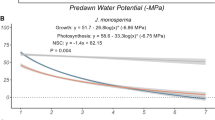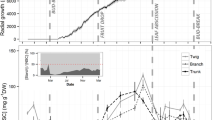Abstract
Plants in most biomes are thought to be living at their hydraulic limits, and alterations to precipitation patterns consistent with climate change trends are causing die-back in forests across the globe1,2,3,4. However, within- and among-species variation in plant traits that promote persistence and adaptation under these new rainfall regimes may reduce mortality in these changing climates5,6. Storage of non-structural carbohydrates (NSCs) is posited as an important trait for resistance and resilience of forests to climate-change-induced drought, but the underlying mechanisms remain unclear7,8,9,10. Here we demonstrate a positive relationship between NSCs and drought survival by manipulating NSC concentrations within seedlings of ten tropical tree species. Seedlings experimentally enriched in NSCs showed higher stem water potentials and sustained NSCs during drought. NSC use for maintenance of osmoregulation and hydraulic function therefore seems to underlie improved drought resistance. That drought mortality is delayed by higher NSC concentrations has implications for predicting the impacts of climate change on forest die-back2,4 and may help focus restoration efforts on species that increase the resistance and resilience of forests to climate change.
This is a preview of subscription content, access via your institution
Access options
Subscribe to this journal
Receive 12 print issues and online access
$209.00 per year
only $17.42 per issue
Buy this article
- Purchase on Springer Link
- Instant access to full article PDF
Prices may be subject to local taxes which are calculated during checkout




Similar content being viewed by others
References
Potts, M. Drought in a Bornean everwet rain forest. J. Ecol. 91, 467–474 (2003).
Phillips, O. L. et al. Drought-mortality relationships for tropical forests. New Phytol. 187, 631–646 (2010).
Anderegg, W. et al. The roles of hydraulic and carbon stress in a widespread climate-induced forest die-off. Proc. Natl Acad. Sci. USA 109, 233–237 (2012).
Choat, B. et al. Global convergence in the vulnerability of forests to drought. Nature 491, 752–755 (2012).
Clark, J. S. et al. Individual-scale inference to anticipate climate-change vulnerability of biodiversity. Phil. Trans. R. Soc. Lond. B. Biol. Sci. 367, 236–246 (2012).
Yachi, S. & Loreau, M. Biodiversity and ecosystem productivity in a fluctuating environment: the insurance hypothesis. Proc. Natl Acad. Sci. USA 96, 1463–1468 (1999).
Sala, A., Woodruff, D. R. & Meinzer, F. C. Carbon dynamics in trees: Feast or famine? Tree Physiol. 32, 764–775 (2012).
Adams, H. D. et al. Temperature sensitivity of drought-induced tree mortality portends increased regional die-off under global-change-type drought. Proc. Natl Acad. Sci. USA 106, 7063–7066 (2009).
Leuzinger, S., Bigler, C., Wolf, A. & Korner, C. Poor methodology for predicting large-scale tree die-off. Proc. Natl Acad. Sci. USA 106, E106 (2009).
Dietze, M. C. et al. Nonstructural carbon in woody plants. Annu. Rev. Plant Biol. 65, 667–687 (2013).
Williams, J. J. W., Jackson, S. T. & Kutzbach, J. J. E. Projected distributions of novel and disappearing climates by 2100 AD. Proc. Natl Acad. Sci. USA 104, 5738–5742 (2007).
Buckley, L. B. & Kingsolver, J. G. Functional and phylogenetic approaches to forecasting species’ responses to climate change. Annu. Rev. Ecol. Evol. Syst. 43, 205–226 (2012).
Chapin, F. I., Schulze, E. & Mooney, H. The ecology and economics of storage in plants. Annu. Rev. Ecol. Syst. 21, 423–447 (1990).
Myers, J. A. & Kitajima, K. Carbohydrate storage enhances seedling shade and stress tolerance in a neotropical forest. J. Ecol. 95, 383–395 (2007).
Hartmann, H., Ziegler, W., Kolle, O. & Trumbore, S. Thirst beats hunger-declining hydration during drought prevents carbon starvation in Norway spruce saplings. New Phytol. 200, 340–349 (2013).
McDowell, N. G. Mechanisms linking drought, hydraulics, carbon metabolism, and vegetation mortality. Plant Physiol. 155, 1051–1059 (2011).
Sala, A., Piper, F. & Hoch, G. Physiological mechanisms of drought-induced tree mortality are far from being resolved. New Phytol. 186, 274–281 (2010).
Sevanto, S., McDowell, N. G., Dickman, L. T., Pangle, R. & Pockman, W. T. How do trees die? A test of the hydraulic failure and carbon starvation hypotheses. Plant Cell Environ. 37, 153–161 (2014).
Adams, H. D. et al. Nonstructural leaf carbohydrate dynamics of Pinus edulis during drought-induced tree mortality reveal role for carbon metabolism in mortality mechanism. New Phytol. 197, 1142–1151 (2013).
Mitchell, P. J. et al. Drought response strategies define the relative contributions of hydraulic dysfunction and carbohydrate depletion during tree mortality. New Phytol. 197, 862–872 (2013).
Muller, B. et al. Water deficits uncouple growth from photosynthesis, increase C content, and modify the relationships between C and growth in sink organs. J. Exp. Bot. 62, 1715–1729 (2011).
Fatichi, S., Leuzinger, S. & Korner, C. Moving beyond photosynthesis: From carbon source to sink-driven vegetation modeling. New Phytol. 201, 1086–1095 (2014).
Bucci, S., Scholz, F., Goldstein, G., Meinzer, F. & Sternberg, L. Dynamic changes in hydraulic conductivity in petioles of two savanna tree species: Factors and mechanisms contributing to the refilling of embolized vessels. Plant Cell Environ. 26, 1633–1645 (2003).
Zwieniecki, M. & Holbrook, N. M. Confronting Maxwell’s demon: Biophysics of xylem embolism repair. Trends Plant Sci. 14, 530–534 (2009).
Brodersen, C. R., McElrone, A. J., Choat, B., Matthews, M. A. & Shackel, K. A. The dynamics of embolism repair in xylem: In vivo visualizations using high-resolution computed tomography. Plant Physiol. 154, 1088–1095 (2010).
Wheeler, J. K., Huggett, B. A., Tofte, A. N., Rockwell, F. E. & Holbrook, N. M. Cutting xylem under tension or supersaturated with gas can generate PLC and the appearance of rapid recovery from embolism. Plant Cell Environ. 36, 1938–1949 (2013).
Walsh, R. P. & Newbery, D. M. The ecoclimatology of Danum, Sabah, in the context of the world’s rainforest regions, with particular reference to dry periods and their impact. Philos. Trans. R. Soc. Lond. B. Biol. Sci. 354, 1869–1883 (1999).
Tyree, M., Patiño, S. & Becker, P. Vulnerability to drought-induced embolism of Bornean heath and dipterocarp forest trees. Tree Physiol. 18, 583–588 (1998).
Poorter, L. & Markesteijn, L. Seedling traits determine drought tolerance of tropical tree species. Biotropica 40, 321–331 (2008).
Acknowledgements
This work was financially supported by the Swiss National Science Foundation (Grant 31003A_125461 to A.H.). We thank G. Reynolds for field support. Great appreciation goes to our hard-working staff at the Sabah Biodiversity Experiment, especially P. Ulok, F. Osman and Achung. The Sabah Biodiversity Experiment is part of the Royal Society South East Asia Rainforest Research Programme (Project No. RS243), and this research is manuscript number 10 of the SBE. This manuscript contributes to the UZH University Research Priority Program on Global Change and Biodiversity.
Author information
Authors and Affiliations
Contributions
M.J.O’B. conceived, designed and carried out the experiment, extracted NSC, analysed the data and wrote the manuscript. S.L. contributed in designing the physiological method, analysis and writing. C.D.P. contributed to the study design, analysis and writing. J.T. was the local collaborator helping with the logistics of research in Sabah. A.H. contributed to the study conception, analysis and writing. Revisions were led by M.J.O’B. with input from all authors.
Corresponding author
Ethics declarations
Competing interests
The authors declare no competing financial interests.
Supplementary information
Rights and permissions
About this article
Cite this article
O’Brien, M., Leuzinger, S., Philipson, C. et al. Drought survival of tropical tree seedlings enhanced by non-structural carbohydrate levels. Nature Clim Change 4, 710–714 (2014). https://doi.org/10.1038/nclimate2281
Received:
Accepted:
Published:
Issue Date:
DOI: https://doi.org/10.1038/nclimate2281
This article is cited by
-
Photochemical efficiency and lethal leaf dehydration in seedlings of nine tropical tree species
New Forests (2024)
-
Growth versus storage: response of Pinus tabuliformis and Quercus mongolica seedlings to variation in nutrient supply and its associated effect on field performance
New Forests (2024)
-
Precipitation pattern changed the content of non-structural carbohydrates components in different organs of Artemisia ordosica
BMC Plant Biology (2023)
-
No carbon storage in growth-limited trees in a semi-arid woodland
Nature Communications (2023)
-
Interannual dynamics of stemwood nonstructural carbohydrates in temperate forest trees surrounding drought
Journal of Forestry Research (2023)



